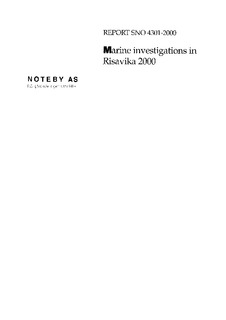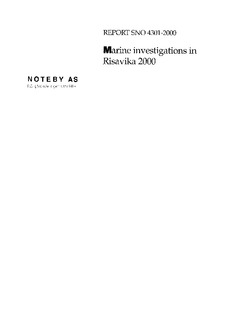| dc.contributor.author | Berge, J. | nb_NO |
| dc.contributor.author | Fagerhaug, A. | nb_NO |
| dc.contributor.author | Rygg, B. | nb_NO |
| dc.contributor.other | Berge, J. - Project manager | nb_NO |
| dc.coverage.spatial | Rogaland | nb_NO |
| dc.date.accessioned | 2014-08-01T10:45:43Z | |
| dc.date.available | 2014-08-01T10:45:43Z | |
| dc.date.issued | 2000 | nb_NO |
| dc.identifier | 4301 | nb_NO |
| dc.identifier.isbn | 82-577-3932-4 | nb_NO |
| dc.identifier.issn | 1894-7948 | nb_NO |
| dc.identifier.uri | http://hdl.handle.net/11250/211052 | |
| dc.description | Årsliste 2000 | nb_NO |
| dc.description.abstract | The present investigation was performed in August 2000 in order to provide updated information on the environmental condition of the marine area surrounding Norske Shell's oil refinery at Sola. The refinery ceased normal operation April 1st 2000. The report comprise results from analysis of metals and hydrocarbons (including polycyclic aromatic hydrocarbons, PAH) in sediments, mussels and semipermeable membranes (SPMDs). Analysis of metals in sediments and mussels did not indicate appreciable leakage from the refinery area to the sea. Municipal discharge of sewage may have caused increased concentrations of benzo(a)pyrene and mercury at one station in Risavika. The concentrations of PAH in the sediment were generally low (insignificantly to moderately polluted). Sediments from one station, near the refinery, contained some heavy oil. The transplanted mussels were generally moderately polluted with PAH. The highest concentrations of PAH in mussels were found near a deep water jetty on the refinery area. The concentration of individual PAH components and SPAH in SPMDs indicates more water accommodated PAH inside Risavika than on the western side of the refinery. A similar conclusion could also be drawn from the analysis of PAH in mussels. The highest concentrations of PAH in SPMD`s were found at the reference site nearer Tananger harbour and not at the stations near the refinery. The results from the studies of soft bottom macrofauna showed a low species diversity in the Tananger harbour. A considerably higher diversity were found at the two stations in Risavika. | nb_NO |
| dc.description.sponsorship | A/S Norske Shell | nb_NO |
| dc.publisher | Norsk institutt for vannforskning | nb_NO |
| dc.relation.ispartofseries | NIVA-rapport;4301 | nb_NO |
| dc.rights | Navngivelse-IkkeKommersiell-DelPåSammeVilkår 3.0 Norge | nb_NO |
| dc.rights.uri | http://creativecommons.org/licenses/by-nc-sa/3.0/no/ | nb_NO |
| dc.subject | undersøkelser-marint | nb_NO |
| dc.title | Marine investigations in Risavika 2000 | nb_NO |
| dc.type | Research report | nb_NO |
| dc.rights.holder | Norsk institutt for vannforskning/Norwegian institute for water research | nb_NO |
| dc.subject.nsi | VDP::Matematikk og naturvitenskap: 400 | nb_NO |
| dc.source.pagenumber | 37 | nb_NO |
| dc.subject.keyword | raffineri | nb_NO |
| dc.subject.keyword | driftsnedleggelse | nb_NO |
| dc.subject.keyword | marine miljø | nb_NO |
| dc.subject.keyword | forurensning | nb_NO |
| dc.subject.keyword | refinery | nb_NO |
| dc.subject.keyword | decommissioning | nb_NO |
| dc.subject.keyword | marine | nb_NO |
| dc.subject.keyword | environment | nb_NO |
| dc.subject.keyword | pollution | nb_NO |
| dc.relation.project | O-20142 | nb_NO |


